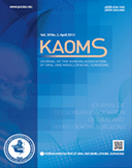Journal of the Korean Association of Oral and Maxillofacial Surgeons
- P-ISSN2234-7550
- E-ISSN2234-5930
- SCOPUS, KCI, ESCI
 ISSN : 2234-7550
ISSN : 2234-7550
Tumor resection from retromolar trigone, posterolateral maxilla, and anterior mandibular ramus using lower cheek flap approach: a case report and review of literature
Abstract
A surgical approach involving the retromolar trigone, posterolateral maxilla, and pterygoid region is the most challenging in the field of maxillofacial surgery. The upper cheek flap (Weber-Ferguson incision) with subciliary extension and the maxillary swing approach have been considered as alterna-tives; however, neither approach provides sufficient exposure of the pterygoid region and the anterior portion of the mandibular ramus. In this report, we describe two cases in which a lower cheek flap approach was used for complete tumor resection in the retromolar trigone and the anterior mandibu-lar ramus. This approach allows full exposure of the posterolateral maxilla and the pterygoid region as well as the retromolar trigone without causing major sensory disturbances to the lower lip. A mental nerve anastomosis after tumor resection was performed in one patient and resulted in approxi-mately 90% sensory recovery in the lower lip. The lower cheek flap approach provides adequate exposure of the posterolateral maxilla, including the pterygoid, retromolar trigone, and mandibular ramus areas. If the mental nerve can be anastomosed during flap approximation, postoperative sensory disturbances to the lower lip can be minimized.
- keywords
- Lower cheek flap, Retromolar trigone, Posterolateral maxilla, Anterior mandibular ramus, Surgical approach
- Downloaded
- Viewed
- 0KCI Citations
- 0WOS Citations